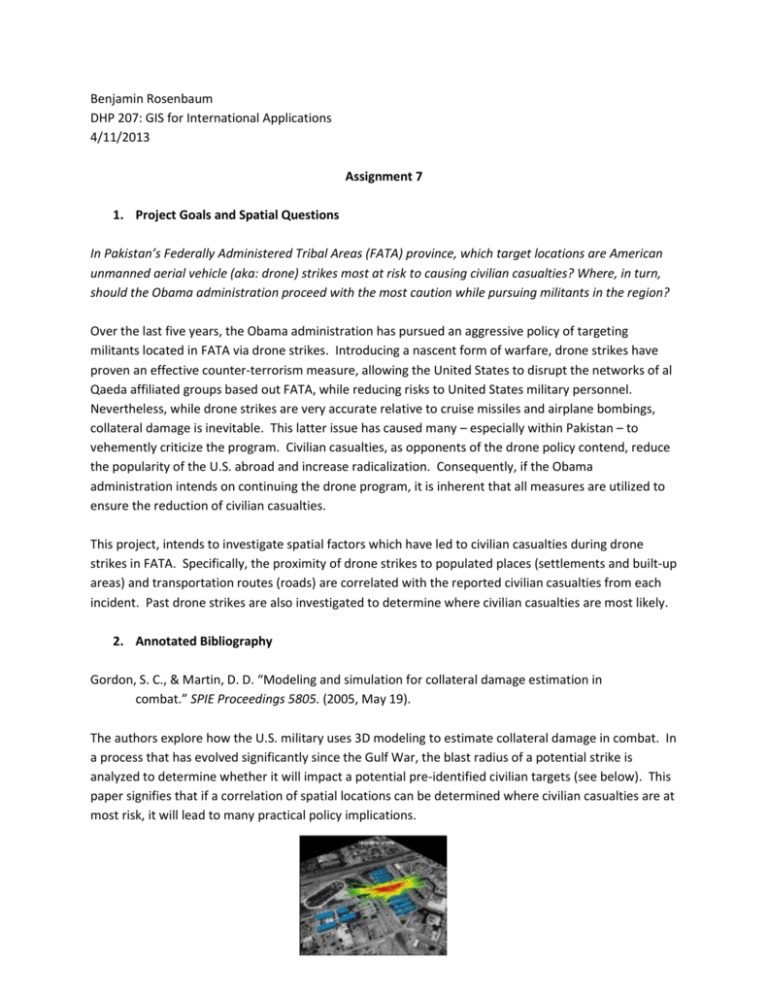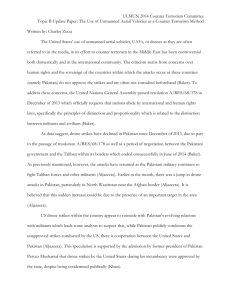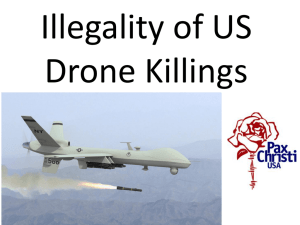Assignment 7 (Rosenbaum)
advertisement

Benjamin Rosenbaum DHP 207: GIS for International Applications 4/11/2013 Assignment 7 1. Project Goals and Spatial Questions In Pakistan’s Federally Administered Tribal Areas (FATA) province, which target locations are American unmanned aerial vehicle (aka: drone) strikes most at risk to causing civilian casualties? Where, in turn, should the Obama administration proceed with the most caution while pursuing militants in the region? Over the last five years, the Obama administration has pursued an aggressive policy of targeting militants located in FATA via drone strikes. Introducing a nascent form of warfare, drone strikes have proven an effective counter-terrorism measure, allowing the United States to disrupt the networks of al Qaeda affiliated groups based out FATA, while reducing risks to United States military personnel. Nevertheless, while drone strikes are very accurate relative to cruise missiles and airplane bombings, collateral damage is inevitable. This latter issue has caused many – especially within Pakistan – to vehemently criticize the program. Civilian casualties, as opponents of the drone policy contend, reduce the popularity of the U.S. abroad and increase radicalization. Consequently, if the Obama administration intends on continuing the drone program, it is inherent that all measures are utilized to ensure the reduction of civilian casualties. This project, intends to investigate spatial factors which have led to civilian casualties during drone strikes in FATA. Specifically, the proximity of drone strikes to populated places (settlements and built-up areas) and transportation routes (roads) are correlated with the reported civilian casualties from each incident. Past drone strikes are also investigated to determine where civilian casualties are most likely. 2. Annotated Bibliography Gordon, S. C., & Martin, D. D. “Modeling and simulation for collateral damage estimation in combat.” SPIE Proceedings 5805. (2005, May 19). The authors explore how the U.S. military uses 3D modeling to estimate collateral damage in combat. In a process that has evolved significantly since the Gulf War, the blast radius of a potential strike is analyzed to determine whether it will impact a potential pre-identified civilian targets (see below). This paper signifies that if a correlation of spatial locations can be determined where civilian casualties are at most risk, it will lead to many practical policy implications. Restrepo, J. A., Spagat, M., Reanier, P., & Suarez, N. F., “Civilian casualties in the Columbian conflict: georeferencing human security.” Twenty-Fifth Annual ESRI International User Conference. (2005, July 25-29). Retrieved from http://proceedings.esri.com/library/userconf/proc05/papers/pap1788.pdf This paper, presented at a conference hosted by ESRI, examines guerilla violence against civilians in Columbia from 1988 to 2004 using GIS. One of the most persuasive measures the authors use to study civilian casualties is by performing a spatial analysis on population density within Columbia. Through this technique, they are able to determine where civilian casualties in Columbia are most likely to occur. For example, bombings in large cities caused more injuries relative to bombings in small – less densely populated – cities. Similar analysis of population density can be utilized to determine indicators where civilian casualties caused by drones are most prevalent in FATA. Johnson, P. B., & Sarbahi, A. “The impact of U.S. drone strikes on terrorism in Pakistan.” (2013, January 3). Retrieved from http://patrickjohnston.info/materials/drones.pdf This article explores the spatial relationship between drone strikes in the FATA region and terrorist attacks in Pakistan and Afghanistan. It concludes that drone strikes reduce terrorist attacks only in nearby areas as militants attempt to avoid locations previously targeted by a drone. To achieve this result, this article analyzed the spillover effect of terrorism in 25 KM increments from the drone strikes. While the type of investigation conducted is different than what I plan to purse, the authors submit the New American Foundation dataset “The Year of the Drones” as an excellent and in depth resource to analyze the spatial relationship of drone strikes in FATA. Williams, B. G. “The CIA’s covert predator drone war in Pakistan, 2004-2010: the history of an assassination campaign.” Studies in Conflict & Terrorism 33:10. (2010, September 21). Williams provides one of the most complete overviews of the U.S. drone campaign in FATA. While scrutinizing the history of drone strikes and their reception in Pakistan, the author also addresses the spatial dimensions of the program. It is explicitly stated that drone strikes are targeted against militant houses and compounds as well as convoys. Accordingly, transportation routes (such as roads) are an important factor to examine when analyzing the civilian casualty rates of drone strikes in FATA. 3. GIS Data Layers and Tabular Datasets Name Pakistan Tehsils Pakistan Roads Data Source United Nations Office for the Coordination of Humanitarian Affairs (OCHA) University of Georgia – ITOS & International Steering Committee for Global Mapping (ISCGM) Description ESRI Shapefile representing the boundaries of Tehsils within Pakistan (Administrative 3 level units) ESRI Shapefile representing roads (primary, secondary, and other) within Pakistan Name Pakistan Built-Up Areas Pakistan Settlements Year of the Drones Data Source University of Georgia – ITOS & ISCGM Pakistan Tehsil Population Estimates for 2010 World Gazetteer via Human Response: Common and Fundamental Operational Datasets Registry http://cod.humanitarianresponse.info/ sites/default/files/pakistan_tehsil_pop ulation_estimates_for_2010.xls OCHA New America Foundation http://counterterrorism.newamerica.n et/drones Description ESRI Shapefile with points represent builtup places in Pakistan ESRI Shapefile with points represent settlements in Pakistan Dataset which includes information on geographic location and total killed (both militants and non-militants) for each drone strike conducted in Pakistan. All information is collected through opensource articles (ex. CNN, New York Times, The Guardian etc.) Dataset which provides detailed population information (1998 and 2010) from Pakistan down to the Tehsil level. Categories include: household size, native language, employment data, education levels, literacy etc. 4. Data Creation Process and Analytical Steps To georeference drone strikes in FATA into ArcGIS, I downloaded the KML file from the NAF Year of the Drones dataset and converted the information into a Shapefile. While the spatial information successfully projected into the ArcGIS (see right for FATA) casualty information for each incident were lost in the text fields. To overcome this obstacle, I utilized the editor feature in ArcGIS, and manually entered casualty counts for each incident (274 in total) which corresponded to the data available online (see below). I coded the information cautiously, using the middle ground when casualty counts between sources conflicted and separating each incident into four categories: total killed, leaders killed, militants killed, and others killed. The ‘others killed’ indicates the casualties of individuals who were neither identified as militants or militant leaders. It is from this group which civilian casualties can be best estimated. The second set of data which I created was to import the population statistics for each Tehsil. To achieve this, I ‘joined’ the Pakistan Tehsils boundary Shapefile with the Pakistan Tehsil Population Estimate Excel sheet (see right with population statistics). To ensure that the information aligned correctly before the ‘join,’ I created an FID Tehsil row in the Excel sheet and manually entered an FID number which corresponded with the name of the same Tehsil in the Shapefile (see below). In an effort to understand drone strike casualties in relation to population density, I will calculate the Tehsils in FATA which are the most densely populated and compare this information to the Tehsils where the most drone strikes occurred which caused civilian casualties. To achieve this last step I will conduct a ‘spatial join’ between the drones strikes layer and the Tehsil boundary layer (which has already been ‘joined’ with population information). As a method of analyzing high-risk locations for drone strikes in terms of civilian casualties, I will use the spatial analysis feature to create a ‘point density’ raster to identify which strikes caused the most collateral damage (see right). Estimates for civilian casualties in an incident range from 30 to 1 person and there were 69 such incidents. I can also create a ‘point density’ raster which will include all 274 incidents. To determine where drone strikes which caused casualties are most prevalent, I can then use the ‘raster calculater’ to subtract the civilian casualties raster from the total strikes raster indicating areas most at risk. Finally, I will use the proximity feature to determine if high casualty incidents were more or less likely to occur near roads, settlements, and built-up areas (towns). Thus, it will be possible to predict high-risk areas for regions where drone strikes have not occurred (and perhaps apply this information to future conflicts). 5. Products Maps The main map will be a heat map of high risk and low risk areas of drone strikes in FATA Smaller maps will include o Heat map of drone strikes in FATA o Heat map of civilian casualties in FATA o Population density of Tehsils in FATA, this will include points with settlements, built-up areas, and roads o Drone strike density of Tehsils in FATA, this will include points with drone strikes o Civilian casualties within Tehsils in FATA, this will include points with drone strikes which resulted in civilian casualties Table Total # of drone strikes with # of casualties (breaking this information down by civilians and militants)




